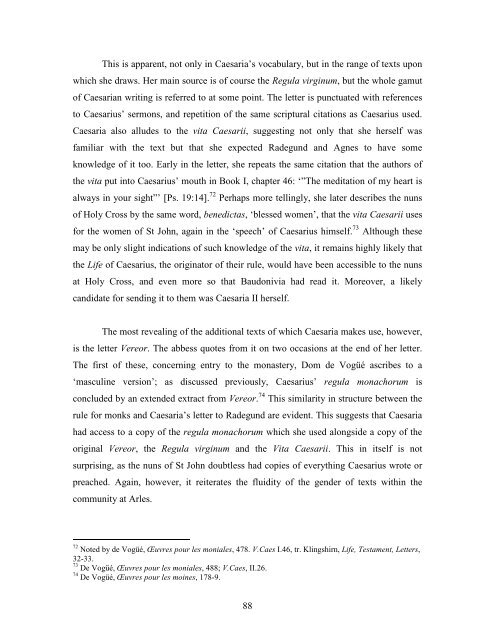Lindsay Rudge PhD Thesis - University of St Andrews
Lindsay Rudge PhD Thesis - University of St Andrews
Lindsay Rudge PhD Thesis - University of St Andrews
Create successful ePaper yourself
Turn your PDF publications into a flip-book with our unique Google optimized e-Paper software.
This is apparent, not only in Caesaria’s vocabulary, but in the range <strong>of</strong> texts upon<br />
which she draws. Her main source is <strong>of</strong> course the Regula virginum, but the whole gamut<br />
<strong>of</strong> Caesarian writing is referred to at some point. The letter is punctuated with references<br />
to Caesarius’ sermons, and repetition <strong>of</strong> the same scriptural citations as Caesarius used.<br />
Caesaria also alludes to the vita Caesarii, suggesting not only that she herself was<br />
familiar with the text but that she expected Radegund and Agnes to have some<br />
knowledge <strong>of</strong> it too. Early in the letter, she repeats the same citation that the authors <strong>of</strong><br />
the vita put into Caesarius’ mouth in Book I, chapter 46: ‘”The meditation <strong>of</strong> my heart is<br />
always in your sight”’ [Ps. 19:14]. 72 Perhaps more tellingly, she later describes the nuns<br />
<strong>of</strong> Holy Cross by the same word, benedictas, ‘blessed women’, that the vita Caesarii uses<br />
for the women <strong>of</strong> <strong>St</strong> John, again in the ‘speech’ <strong>of</strong> Caesarius himself. 73 Although these<br />
may be only slight indications <strong>of</strong> such knowledge <strong>of</strong> the vita, it remains highly likely that<br />
the Life <strong>of</strong> Caesarius, the originator <strong>of</strong> their rule, would have been accessible to the nuns<br />
at Holy Cross, and even more so that Baudonivia had read it. Moreover, a likely<br />
candidate for sending it to them was Caesaria II herself.<br />
The most revealing <strong>of</strong> the additional texts <strong>of</strong> which Caesaria makes use, however,<br />
is the letter Vereor. The abbess quotes from it on two occasions at the end <strong>of</strong> her letter.<br />
The first <strong>of</strong> these, concerning entry to the monastery, Dom de Vogüé ascribes to a<br />
‘masculine version’; as discussed previously, Caesarius’ regula monachorum is<br />
concluded by an extended extract from Vereor. 74 This similarity in structure between the<br />
rule for monks and Caesaria’s letter to Radegund are evident. This suggests that Caesaria<br />
had access to a copy <strong>of</strong> the regula monachorum which she used alongside a copy <strong>of</strong> the<br />
original Vereor, the Regula virginum and the Vita Caesarii. This in itself is not<br />
surprising, as the nuns <strong>of</strong> <strong>St</strong> John doubtless had copies <strong>of</strong> everything Caesarius wrote or<br />
preached. Again, however, it reiterates the fluidity <strong>of</strong> the gender <strong>of</strong> texts within the<br />
community at Arles.<br />
72<br />
Noted by de Vogüé, Œuvres pour les moniales, 478. V.Caes I.46, tr. Klingshirn, Life, Testament, Letters,<br />
32-33.<br />
73<br />
De Vogüé, Œuvres pour les moniales, 488; V.Caes, II.26.<br />
74<br />
De Vogüé, Œuvres pour les moines, 178-9.<br />
88

















